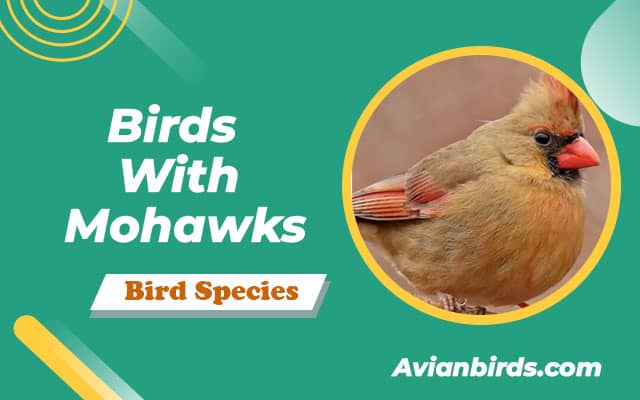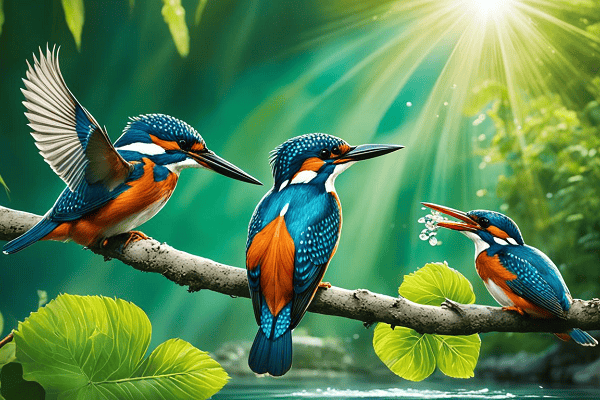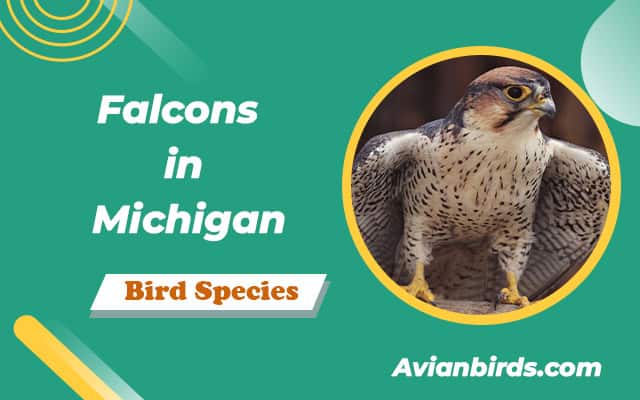15 Tremendous Birds With Mohawks (With Pictures)
Have you ever seen birds with mohawks? Nature, with its diverse array of wild and common birds, never ceases to amaze me. In this article, I’ll introduce you to 15 spectacular birds that rock their own unique mohawks. Get ready to be captivated by their striking appearance and discover the wonders of avian fashion.
Here are the main points:
- Explore the fascinating world of birds with mohawks
- Discover the diverse species that sport these unique hairstyles
- Marvel at their stunning plumage and distinctive crests
- Learn about their natural habitats and behaviour
- Get up close with incredible pictures of these feathered trendsetters
Discover 15 Different Types Of Birds With Mohawks
1. Grey Crowned Crane (Balearica Regulorum)
- Scientific Name: Balearica regulorum
- Size: 3.3 to 4.9 feet (1 to 1.5 meters) in height
- Weight: 4.5 to 6.7 kg (10 to 15 lbs)
- Lifespan: 22 to 30 years in the wild
- Diet: Omnivorous, feeding on grasses, seeds, insects
Meet the majestic grey-crowned crane, also known by its scientific name, Balearica regulorum. This incredible bird is native to the sub-Saharan region of Africa and is renowned for its stunning appearance, highlighted by its prominent mohawk-like crest.
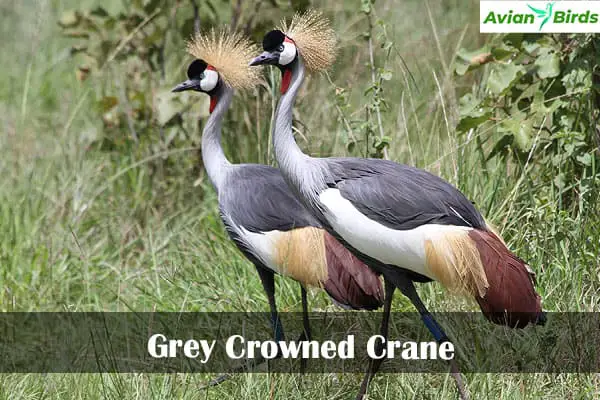
The titmouse Grey crowned crane, a notable mohawk bird, is often considered one of the most beautiful and elegant birds in the world. Standing at around three feet tall, it possesses a slender body and long legs, accentuated by its remarkable plumage. Its body is predominantly grey, with shades of black and white adorning its wings, and a vibrant red area around its eyes. However, it is the crowned crane’s unique crest that truly captures attention. Featuring a distinctive arrangement of stiff golden feathers, it forms a coveted mohawk-like hairstyle on its head.
The Symbolism of the Grey-Crowned Crane
Throughout history, the parrot grey crowned crane has played a significant role in various cultures and societies. Symbolically, this magnificent bird, similar to types of birds with mohawks, often represents grace, elegance, and longevity. In Uganda, it was even designated as the national bird, serving as a proud emblem of the country’s rich natural heritage.
Despite its regal appearance, the grey-crowned crane is an approachable and sociable bird. It is known for gathering in flocks, engaging in complex courtship displays, and performing intricate dances. These elaborate rituals not only serve as a means of attracting mates but also contribute to the cohesion and dynamics within their social groups.
When it comes to habitat, these birds with mohawks primarily resides in wetland areas such as marshes, savannas, and grasslands. These habitats provide the crane with the necessary resources, including food sources like insects, small amphibians, and vegetation.
| Grey Crowned Crane | Balearica Regulorum |
|---|---|
| Family | Gruidae |
| Size | Height: 3-4 feet |
| Habitat | Wetlands, marshes, grasslands |
| Diet | Insects, small amphibians, vegetation |
| Status | Near Threatened |
Unfortunately, while the grey-crowned crane’s population is not currently classified as endangered, it is considered “Near Threatened” due to habitat loss, poaching, and other human activities that disrupt their natural ecosystems.
Observing a grey-crowned crane in the wild or even in captivity is a truly captivating experience. Its gracefulness, striking appearance, and unique mohawk-like crest make it a standout among other avian species. Whether you’re an avid bird enthusiast or simply appreciate the wonders of nature, encountering a grey-crowned crane is an awe-inspiring moment that is sure to leave a lasting impression.
2. Northern Cardinal (Cardinalis Cardinalis)
- Scientific Name: Cardinalis cardinalis
- Size: 8.3 to 9.1 inches (21 to 23 cm) in length
- Weight: 42 to 48 grams (1.5 to 1.7 oz)
- Lifespan: 3 years on average, up to 15 years in the wild
- Diet: Omnivorous, primarily seeds, grains, fruits, and insects
The northern cardinal, scientifically named Cardinalis, it is a medium-sized bird belonging to the cardinal family, cardinals. Additionally, its attention-grabbing crest, usually red, sits proudly atop its head, making it stand out in the crowd.
Another fascinating feature of the northern cardinal is its vibrant plumage, especially in the males, who flaunt a bright red coat. Furthermore, females boast a mix of gray and reddish-brown feathers and making them easy to distinguish from their male counterparts.
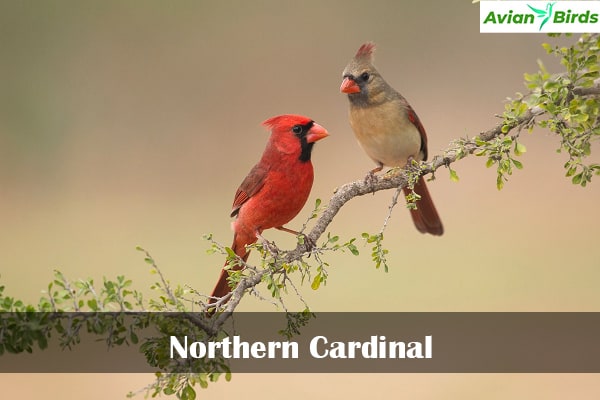
In terms of diet, northern cardinals are adaptable eaters, feasting on seeds, fruits, and insects. Also, They use their robust beaks to crack open seeds and enjoy munching on various berries.
During the breeding season, These male northern cardinal birds with mohawks serenade potential mates with their melodious songs, filling the air with cheerful whistles and trills. Plus, if you’re keen on attracting these lovely birds to your backyard, setting up bird feeders with sunflower seeds and providing dense shrubs for nesting can do the trick.
Here are fun facts about the Northern Cardinal:
- The northern cardinal is the official state bird of seven states in the United States: Illinois, Indiana, Kentucky, North Carolina, Ohio, Virginia, and West Virginia.
- These birds have a lifespan of around three years in the wild, although some individuals have been known to live up to 15 years.
- Both male and female northern cardinals take part in nest building, with the female responsible for most of the construction.
3. Sulphur-crested Cockatoo (Cacatua Galerita)
- Scientific Name: Cacatua galerita
- Size: 18 to 22 inches (46 to 56 cm) in length
- Weight: 350 to 600 grams (12 to 21 oz)
- Lifespan: 40 to 60 years, sometimes longer in captivity
- Diet: Omnivorous, feeding on seeds, nuts, fruits, berries, and occasionally insects
Get ready to meet the fascinating sulfur-crested cockatoo, a large white bird with a distinctive mohawk-like crest. With its striking appearance and playful personality, this cockatoo has captured the hearts of bird enthusiasts worldwide.
Native to Australia and New Guinea, the sulphur-crested cockatoo inhabits a variety of habitats, including forests, woodlands, and urban areas. Its adaptable nature allows it to thrive in both natural and human-altered environments.
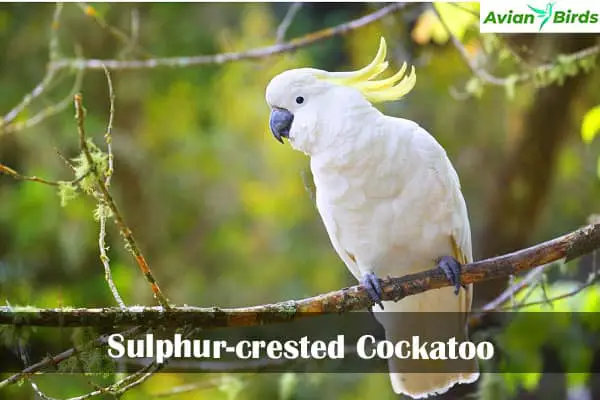
One of the most remarkable features of the sulfur-crested cockatoo is its vibrant yellow crest, which can be raised or lowered depending on its mood or level of excitement. This iconic plume, along with its piercing blue eyes, gives the cockatoo a captivating and charming expression.
The sulphur-crested cockatoo is known for its intelligence and exceptional vocal abilities. It can mimic a wide range of sounds, including human speech, making it an entertaining companion and a popular choice among bird lovers.
These social birds are often seen in flocks, flying gracefully or perched in trees, emitting their distinctive screeching calls. They use their powerful beaks to crack open nuts and seeds and are known to display playful and curious behaviors.
| Distinctive Features | Behavioral Traits | Habitat |
|---|---|---|
| Large white body Bright yellow crest Piercing blue eyes | Intelligent Mimicry skills Social | Australian forests and woodlands, home to many birds sporting impressive Urban areas Human-altered environments |
Conservation efforts are crucial to protect the sulphur-crested cockatoo and its habitat from threats such as deforestation and illegal wildlife trade. By raising awareness and supporting conservation initiatives, we can ensure that future generations get to witness the beauty of this magnificent bird.
4. Great Blue Turaco (Corythaeola Cristata)
- Scientific Name: Tauraco corythaix
- Size: 20 to 24 inches (50 to 61 cm) in length
- Weight: 250 to 300 grams (8.8 to 10.6 oz)
- Lifespan: 15 to 20 years in the wild
- Diet: Primarily fruit, but also leaves, flowers, and seeds
Great Blue Turaco is a remarkable bird indeed! Native to the dense forests of Western and Central Africa, it stands out with its vibrant blue and green feathers, along with a striking red crest atop its head. As a primarily frugivorous bird, it feeds mainly on fruits, supplemented with leaves, flowers, buds, insects, and occasionally small vertebrates.
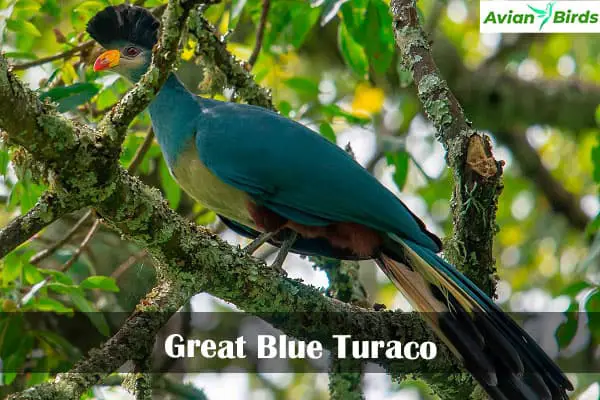
These social birds often gather in small family groups or pairs and communicate through a range of calls. Great Blue Turacos play a vital role in seed dispersal as they consume fruits and aid in spreading seeds throughout the forest.
Absolutely! Encountering a Great Blue Turaco in the wild is indeed a special experience, but it’s crucial to respect their protected status and observe them from a distance to aid in their conservation efforts.
5. Western Crowned Pigeon (Goura Cristata, a mohawk bird)
- Scientific Name: Goura cristata
- Size: 26 to 30 inches (66 to 76 cm) in length
- Weight: 1.1 to 2.0 kg (2.4 to 4.4 lbs)
- Lifespan: 15 to 20 years in the wild
- Diet: Primarily fruit, seeds, and leaves, with occasional invertebrates
Prepare to be captivated by the majestic beauty of the Western Crowned Pigeon, a large bird that dons a striking mohawk-like crest. These magnificent creatures are known for their unique appearance and fascinating behavior.

The Distinct Features of the Western Crowned Pigeon
Standing out among other pigeon species, the Western Crowned Pigeon showcases stunning features that mesmerize all who encounter them. With their vibrant blue-grey plumage, deep maroon breast, and intricate white belly feathers, these birds are a true marvel of nature.
However, what truly sets them apart is their impressive crown-like crest, resembling a regal mohawk. Made up of elongated feathers, the crest isn’t just for show; it accentuates their regal stature and adds an air of grandeur to their already striking appearance.
Habitat and Behavior
The Western Crowned Pigeon is endemic to the dense rainforests of Papua New Guinea and Indonesia, where it inhabits lowland areas with ample access to water sources. They are predominantly found in undisturbed primary forests, making their conservation a top priority.
These pigeons are known for their calm and gentle nature, often seen perched on branches or walking gracefully on the forest floor. They are primarily ground-dwellers, foraging for fruits, seeds, and fallen berries. Their diet plays a crucial role in dispersing seeds throughout their forest habitat, contributing to the ecosystem’s overall health and vitality.
An Imperiled Species
The Western Crowned Pigeon, classified as vulnerable by the International Union for Conservation of Nature (IUCN), faces numerous threats to its survival. Habitat loss due to deforestation, hunting for its feathers and meat, and the illegal pet trade pose significant challenges to their population.
Conservation efforts and programs are crucial in ensuring the future of these magnificent birds. Supporting organizations dedicated to protecting their habitat, combating illegal trade, and raising awareness can make a significant impact in preserving the Western Crowned Pigeon and its remarkable existence.
| Common Name | Scientific Name | Habitat | Conservation Status |
|---|---|---|---|
| Western Crowned Pigeon | Goura Cristata | Dense rainforests of Papua New Guinea and Indonesia | Vulnerable |
6. Eurasian Hoopoe (Upupa Epops)
- Scientific Name: Upupa epops
- Size: 12 to 14 inches (30 to 36 cm) in length
- Weight: 46 to 89 grams (1.6 to 3.1 oz)
- Lifespan: 9 to 10 years in the wild
- Diet: Insects, small invertebrates, and some plant material like seeds and berries
Discover the Eurasian Hoopoe, an exquisite bird with an iconic mohawk-like crest. Known scientifically as Upupa Epops, this fascinating species is found across Europe, Asia, and parts of Africa. The Eurasian Hoopoe’s unique appearance and charming behaviors make it a favorite among bird enthusiasts.
Nesting Habits:
One remarkable aspect of the Eurasian Hoopoe’s lifestyle is its nesting habits. Unlike most birds that build nests in trees, the Hoopoe prefers to create its home in natural cavities such as hollow trees, rock crevices, or even burrows abandoned by other animals. The female Hoopoe meticulously prepares the nesting chamber, lining it with soft materials like grass, feathers, and fur. This cozy haven serves as a safe space for raising their young.
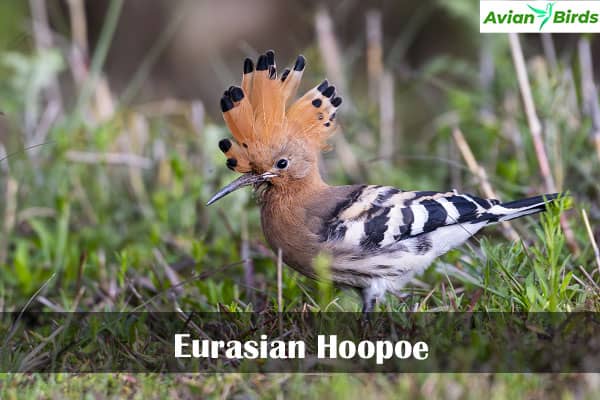
Diet:
The Eurasian Hoopoe has a diverse diet that mainly consists of insects, making it an invaluable asset for natural pest control. Its long, slender beak allows it to probe the ground, seeking out worms, beetles, and other small invertebrates. The Hoopoe’s excellent hearing enables it to detect the movements of hidden prey, making it highly efficient in capturing its meals.
Where to Find Them:
The Eurasian Hoopoe Can be spotted in a variety of habitats, including woodlands, open fields, savannahs, and even urban parks and gardens, home to many common birds and wild birds. This adaptable bird, akin to titmice in its agility, thrives in areas with suitable nesting sites, abundant insects, and access to water sources. Keep your eyes peeled for its distinctive silhouette, rich chestnut plumage, and, of course, the magnificent crest that gives it a punk-rock appearance.
“The Eurasian Hoopoe’s striking crest and fascinating lifestyle make it a true gem in the avian world.” – Birdwatching Magazine
7. Palm Cockatoo (Probosciger Aterrimus)
- Scientific Name: Probosciger aterrimus
- Size: 24 to 26 inches (61 to 66 cm) in length
- Weight: 400 to 600 grams (14 to 21 oz)
- Lifespan: 40 to 60 years in the wild, up to 80 years in captivity
- Diet: Seeds, nuts, fruits, berries, and sometimes insects
Discover the fascinating world of the palm cockatoo, a majestic bird native to Australia. Known for its bold sound and signature mohawk, the palm cockatoo is a true icon of the avian kingdom.
The palm cockatoo, scientifically known as Probosciger aterrimus, is the largest cockatoo species, reaching up to 24 inches (60 cm) in length. These striking birds boast a distinctive crest on their heads, resembling a mohawk haircut, which adds to their unique charm.
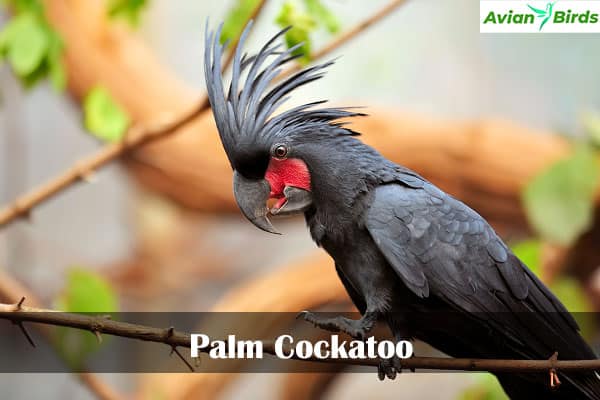
One of the most remarkable features of the palm cockatoo is its incredible vocal abilities. Males are known for their loud calls, which can be heard over long distances, making them one of the loudest birds in the world. These distinctive calls are an essential part of their social behavior, used for communication and attracting mates.
The palm cockatoo’s habitat consists of the rainforests and wooded areas of northern Australia and New Guinea. They are highly specialized in their foraging behavior and have a varied diet that includes fruits, nuts, seeds, and insects.
These birds are incredibly intelligent and have been observed using tools in the wild. They use sticks and other objects to drum on hollow trees, producing rhythmic sounds as part of their courtship displays.
The palm cockatoo has a long lifespan, with individuals living up to 60 years in the wild. These birds are monogamous, forming strong pair bonds that can last a lifetime.
Interesting Facts about the Palm Cockatoo:
- The palm cockatoo’s scientific name, Probosciger aterrimus, translates to “very dark proboscis,” referring to its distinctive black bill.
- They have a complex courtship display that involves drumming with sticks and vocalizations.
- Palm cockatoos have been observed creating and using tools, primarily for percussion.
- These birds have a large range of vocalizations, including deep growling sounds and high-pitched screeches.
8. Great Curassow (Crax Rubra)
- Scientific Name: Crax rubra
- Size: 28 to 34 inches (71 to 86 cm) in length
- Weight: 2.3 to 4.0 kg (5 to 8.8 lbs)
- Lifespan: 20 to 25 years in the wild
- Diet: Fruits, seeds, leaves, and small invertebrates
Absolutely! The great curassow is a imposing bird renowned for its magnificent crest, adding to its regal appearance. Found in the tropical rainforests of Central and South America, including countries like Belize, Costa Rica & Panama, Colombia, and Brazil, also they thrive in dense forests with abundant fruits, berries, leaves, and insects.
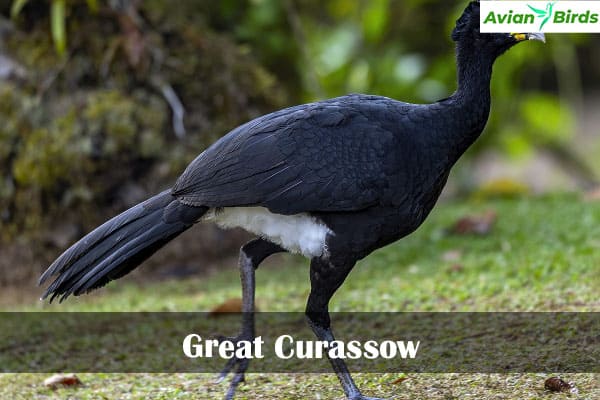
Their striking crest, erected during pleasure or displays of dominance, serves as a visual signal to others, indicating health, strength, and readiness to breed. Moreover, Beyond just aesthetics, it plays a pivotal role in attracting mates during the breeding season.
Great curassows have an omnivorous diet, feasting on fruits, berries, seeds, flowers, insects, spiders, snails, and occasionally small reptiles or amphibians. Their diverse diet aids in seed dispersal, contributing to forest revival.
unluckily, also these birds face threats like habitat loss due to deforestation and hunting for meat and feathers. Moreover, this Conservation efforts are vital for safeguarding these iconic birds and preserving their beauty for future generations.
The Striking Plumage of the Great Curassow
The plumage of the great curassow is truly remarkable. The male birds have black feathers with a bluish sheen, while the females have a more brownish coloration. Both sexes showcase intricate patterns and distinctive features, such as white belly feathers, a bright blue breast shield, and a bold black crest on their heads. These striking colors and patterns aid in camouflage and attract potential mates during courtship displays, showcasing how birds sport their best looks for survival and reproduction.
Here’s a visual representation of the titmouse great curassow‘s striking plumage:
| Species | Male Plumage | Female Plumage |
|---|---|---|
| Great Curassow | Black with bluish sheen, white belly feathers, bright blue breast shield, and black crest | Brownish with white belly feathers, dark brown crest |
As you can see, the great curassow is a true beauty of the rainforest. It’s impressive
9. Steller’s Jay (Cyanocitta Stelleri)
- Scientific Name: Cyanocitta stelleri
- Size: 13 to 13.5 inches (33 to 34 cm) in length
- Weight: 70 to 100 grams (2.5 to 3.5 oz)
- Lifespan: 7 to 16 years in the wild
- Diet: Omnivorous, including seeds, nuts, fruits, insects
Steller’s Jay is a striking birds sporting black and blue feathers along with a distinctive mohawk. Found from Nicaragua to Alaska in western North America, they prefer coniferous forests but can also be spotted in human-populated areas like campgrounds and parks.
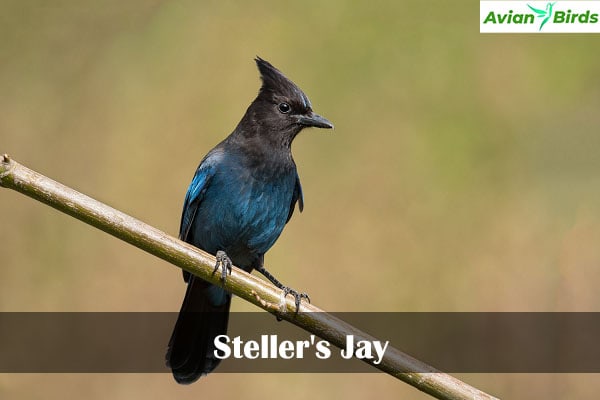
These blue jays birds with mohawks are omnivores and munching on berries, seeds, nuts, insects, eggs, and even nestlings. If you have a feeder and you’re in their habitat range, expect them to drop by for peanuts, suet, and sunflower seeds.
Distinctive Traits of Steller’s Jay
- Size: Approximately 11-12 inches in length
- Habitat: Found in coniferous forests throughout western North America
- Feeding Habits: Omnivorous diet consisting of insects, seeds, berries, and occasionally small vertebrates
- Nesting: Builds cup-shaped nests out of twigs, often placed on tree branches
- Range: Steller’s Jays are residents of the western part of North America, from Alaska to California and east to the Rocky Mountains
The Steller’s Jay is a curious and adaptable species, often seen exploring picnic areas or campsites in search of food. These birds are resourceful, using their intelligence to find creative ways to access hard-to-reach food sources.
Next time you find yourself in the vast forests of western North America, keep an eye out for the magnificent Steller’s Jay. Their striking appearance, distinct calls, and inquisitive nature are sure to leave a lasting impression on any bird lover.
| Distinctive Features | Description |
|---|---|
| Vibrant Blue Plumage | The Steller’s Jay showcases a stunning array of blue feathers, creating a visually captivating spectacle. |
| Prominent Crest, a feature that you’ll often see accentuating the regal stature of these remarkable birds. | The bird’s striking crest, resembling a mohawk, adds a touch of regality to its appearance. |
| Intelligent and Vocal | Steller’s Jays possess remarkable intelligence and communicate through various calls and songs. |
| Resourceful Food Seekers, you’ll often see these birds demonstrating their intelligence and adaptability in various environments. | These birds are known for their ability to find innovative ways to access food sources. |
10. Cockatiel (Nymphicus Hollandicus)
- Scientific Name: Nymphicus hollandicus
- Size: 12–14 inches (30–35 cm) in length
- Weight: 2.5–4.2 ounces (70–120 grams)
- Lifespan: 15–25 years in captivity
- Diet: Seeds, fruits, vegetables, pellets, and occasional leafy greens
The cockatiel is a small gray bird with a cool tuft of feathers like a mohawk. Moreover, They’re from Australia and are loved by people who like birds because they’re cute and friendly.
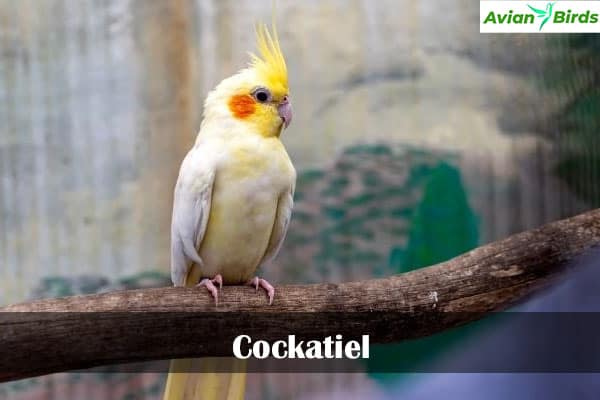
Cockatiels, or Nymphicus hollandicus, have a fancy crest on their heads and come in different colors like gray, yellow, and white. They’re really smart and like being around other birds and people. They can even learn tricks and sing pretty songs!
So, if you’re thinking about getting a pet bird, so cockatiel could be a great option! Furthermore, They’re fun, friendly, and will bring joy to your home.
11. Grey Go-away-bird (Corythaixoides concolor)
- Scientific Name: Crinifer concolor
- Size: 18–20 inches (46–50 cm) in length
- Weight: 7.8–10.5 ounces (220–300 grams)
- Lifespan: Approximately 10–15 years in the wild
- Diet: Fruits, buds, flowers, leaves, and occasionally insects
The Grey Go-away-bird: a sizable, long-tailed bird sporting an impressive mohawk. Dressed predominantly in grey, they sport robust black beaks.
Spot these birds with mohawks atop trees, where they emit their distinctive call, earning them their name. Their signature sound is a resounding nasal “go-away.”
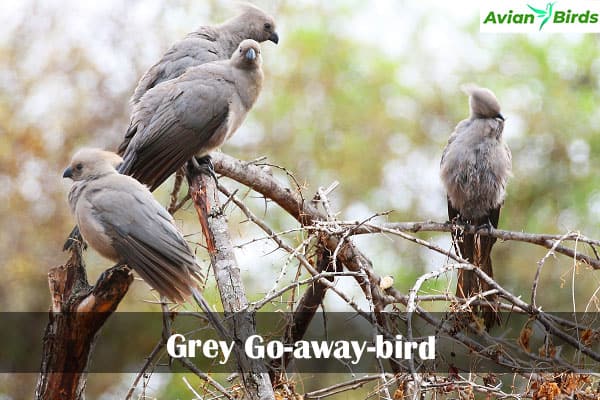
Found in southern Africa, they dwell in savannahs, nearby woodlands, and even urban areas like gardens and parks.
Also, They have a penchant for fruit, but also indulge in leaves, buds, flowers, nectar, snails, and insects. You might even catch them at feeders, enjoying fruits and veggies.
12. Victoria Crowned Pigeon (Goura victoria)
- Scientific Name: Goura victoria
- Size: 28–30 inches (71–75 cm) in length
- Weight: 5.5–7.7 pounds (2.5–3.5 kg)
- Lifespan: 20–25 years in captivity
- Diet: Fruits, seeds, berries, and occasional insects
The Victoria Crowned Pigeon: a big pigeon that calls the swamps and lowland forests of northern New Guinea home.
Sporting a striking appearance, they have blue-grey feathers all over, complemented by a maroon chest, dark blue face patch, red eyes, and a fancy blue crest with white-tipped feathers.

You’ll typically find them foraging on the ground, munching on fruit, seeds, and insects.
13. Tufted Titmouse (Baeolophus bicolor)
- Scientific Name: Baeolophus bicolor
- Size: 5.5–6.3 inches (14–16 cm) in length
- Weight: 0.6–0.9 ounces (18–26 grams)
- Lifespan: 2.1 years on average in the wild, up to 13 years in captivity
- Diet: Insects, seeds, nuts, berries, and occasionally small fruits
The Tufted Titmouse: are small birds rocking with mohawks. Sporting a greyish top, whitish underside, black forehead, and orange sides.
These adorable birds call woodlands, forests, hedgerows, parks, and yards home throughout the year in the eastern United States.
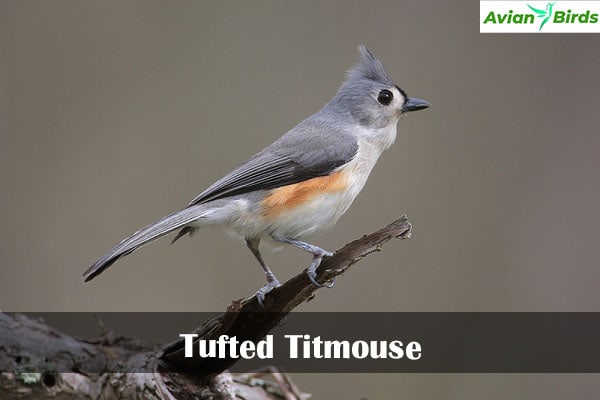
Tufted Titmouses dine on insects, nuts, berries, and seeds.
You might recognize their “peter-peter-peter” call, as they’re often found in yards.
During winter, these birds with mohawks might become regular visitors to your feeder in search of extra grub.
14. Southern Crested Guineafowl (Guttera edouardi)
- Scientific Name: Guttera edouardi
- Size: 17–22 inches (43–56 cm) in length
- Weight: 2.2–3.3 pounds (1–1.5 kg)
- Lifespan: 10–15 years in the wild, up to 20 years in captivity
- Diet: Seeds, fruits, insects, small invertebrates, and vegetation
The Southern Crested Guineafowl, is one of three crested guineafowl species found in Africa, specifically in southern Africa.
With its unique appearance, it boasts a large black body speckled with bluish-white spots, a small head sporting a bare blue-grey face, and a distinctive curly mohawk on top. Bright red eyes and a greyish-white beak complete the look, with a plain black neck and often a visible white patch behind the head.
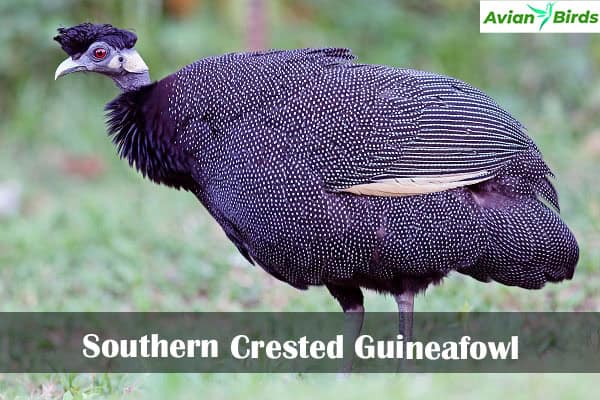
You’ll find these birds with mohawks in thickets, woodlands, and forests, where they feast on a varied diet including fruit, seeds, leaves, shoots, stems, and bulbs, as well as insects, spiders, and millipedes.
15. Long-crested Eagle (Lophaetus occipitalis)
- Scientific Name: Lophaetus occipitalis
- Size: 20–24 inches (50–61 cm) in length
- Weight: 1.7–2.9 pounds (780–1300 grams)
- Wingspan: 3.5–4 feet (105–122 cm)
- Lifespan: Approximately 12–15 years in the wild
- Diet: Small mammals, birds, reptiles, and large insects
The African Harrier-Hawk: it boasts a distinctive white face with black markings around the eyes. The rest of its body is a dark brown-black, except for the white underwing and undertail. Its eyes shine in a golden-yellow hue, and its bill is dark-tipped with a yellow base.
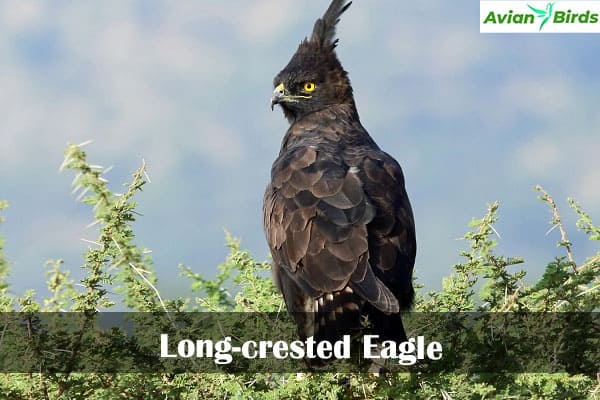
You can spot these birds in grasslands, woodlands, open forests, plantations, fields, parks, and even yards.
Often perched, they’re on the lookout for their next meal, which typically includes rodents, reptiles, and sometimes young birds.
These raptors are widespread across much of sub-Saharan Africa.
Check Our Previous Articles:
FAQ’s About Birds With Mohawks
Q1. What is a bird with a mohawk called?
A punk-rock bird might be a Northern cardinal with a crest.
Q2. What bird has a tuft on its head?
That sounds like a crested titmouse.
Q3. What is the little black birds with mohawks?
It could be a black-capped chickadee.
Q4. What is the purple bird with a mohawk?
That might be a purple-crested turaco.

